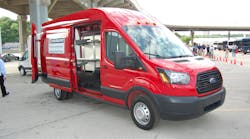Total U.S. light vehicle sales volume remained strong overall in the U.S. at the close of 2014, with more growth expected in 2015, especially where the commercial van market is concerned.
According to monthly sales forecasts developed jointly by consulting firms J.D. Power and LMC Automotive, robust sales in November and December pushed their projected total light-vehicle forecast to 16.5 million units for 2014, with the total light-vehicle sales forecast for 2015 now expected to top 17 million units.
“The prospects for auto sales to overachieve in 2015 are moving closer to reality as 2014 went out on a high note,” said Jeff Schuster, LMC’s senior VP of forecasting. “Economic bliss, driven by job creation, wage growth and low gas prices may drive consumers to showrooms at a faster pace, emphasizing the notion that this recovery may not be over quite yet.”
Where commercial vans are concerned, a spate of new models from a variety of OEMs offering more capability combined with improve fuel economy is beginning to attract the attention of commercial customers.
Yaroslav Hetman, Ford Motor Co.’s brand manager for the full-size Transit, Transit Connect, and E-Series vans told Fleet Owner that November last year marketed the first time sales of the OEM’s new full-size Transit van exceeded those of its older and soon-to-be-discontinued E-Series lineup – some 4,851 units versus 4,151 units for that month.
“It’s out first indication that the new ‘unibody’ van design is beginning to outsell the old frame-on-body design,” he explained.
“It’s showing us that customers are now seeing the value proposition in the new Transit design; a van that offers 46% better fuel economy than the E-Series, 75% more capacity than the largest E-Series model, and 600 pounds more payload capacity,” Hetman pointed out. “That’s all opening up a whole new array of efficiency opportunities for customers.”
Bob Hegbloom, president and CEO of Ram Trucks – a division of Chrysler Group LLC, which is in turn a subsidiary of the newly-minted Fiat Chrysler Corp. – emphasized many of the same themes during a ride and drive event in Austin, TX, to showcase the OEM’s new ProMaster City van.
“What customers want most is cost efficiency and I think we’ve delivered on what they’ve asked for,” he said at that event.
[He offers further details on where those “cost efficiencies” are centered in the video clip below.]
Ford’s Hetman added that sales growth in the commercial van market is also connected to addressing the specific “total cost of operation” or TCO parameters of this segment.
“It’s all about what costs the cargo van operator in the long run,” he explained. Thus vans with more cargo capacity yet better fuel economy offer a lower operating cost footprint versus previous iterations.
Greater durability and lower maintenance expenses are part of the calculation as well, Hetman stressed.
He said Ford has calculated that the 36 month scheduled maintenance cost for a full-size Transit – encompassing oil changes and other routine upkeep expenses – averages about $1,040, while non-scheduled maintenance costs including tires, brakes, etc., averages $4,781.
“Those kinds of numbers are encouraging to customers,” Hetman noted.
Adding more capability is also at the heart of generating growth in sales of new commercial van models.
For example, the new 4x4 optional suspension package being introduced with the 2015 model Sprinter van is part of a concerted effort by the OEM to win more vocational market share located in rougher U.S. topographical areas.
“It’s a great opportunity for us to win the business of the plumber in Bangor, ME; the hotel resort in the Rocky Mountains; natural gas field workers in the Midwest; and oilfield operators in Texas,” Claus Tritt, GM for commercial vans at Daimler AG’s Mercedes-Benz USA (MBUSA) division, explained to Fleet Owner during a special ride and drive event at the Sprinter’s U.S. assembly plant just outside Charleston, SC, late last year.
“It’s an even greater opportunity since at the end of the day it is really a 4x2 suspension that provides 4x4 capability when needed; it’s an on-demand system,” he stressed. “So now we have a true van competitor to the 4x4 Quad Cab pickups in tough places like the oil fields, offering more enclosed load- and tool-carrying capability.”
Tritt also noted at the time that U.S. sales of Sprinter vans went on something of a tear in 2014, with sales expected to be up 19% for 2014 overall versus 2013.
He added that Sprinter sold 21,816 units in the U.S. last year – second only to sales in Germany – with 18,000 units sold this year through September. That’s compared to just 8,500 units sold back in 2010, Tritt pointed out.



